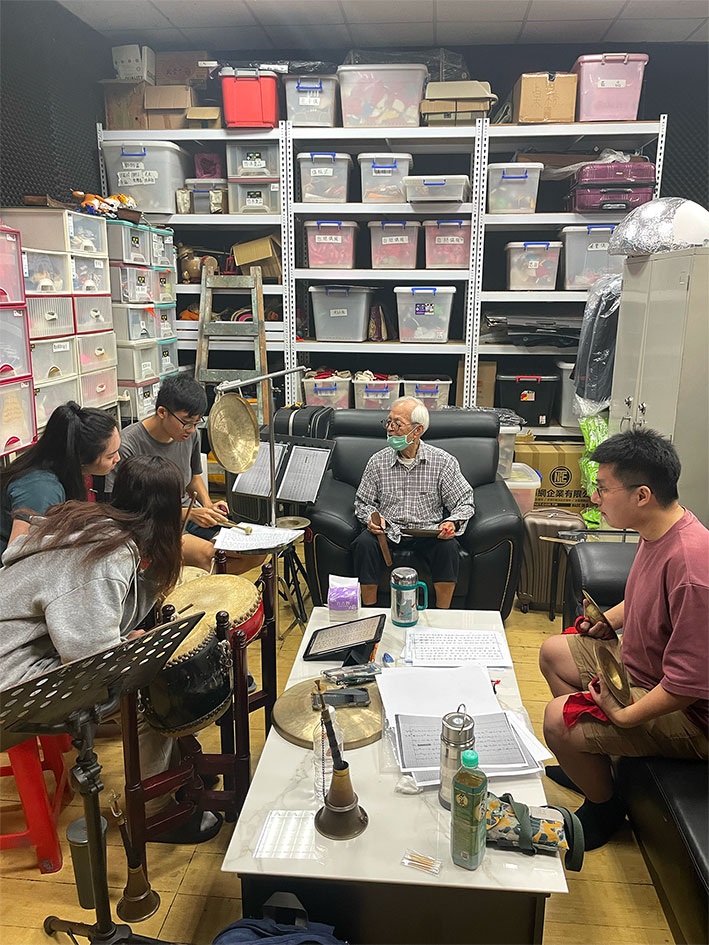Following their invitation, we visit the Taipei Puppet Theater studio in New Taipei on Monday morning, October 7, 2024, to observe 邱火榮 Master Qiu Huo Rong teaching four music students 北管 Beiguan music, pronounced in Taiwanese as pak-kuan. Upon arrival we hear the screeching sound of the 嗩呐 suona (also here) coming out of the building and immediately fasten our pace. While we hurry to take off our shoes to change into plastic slippers before entering the troupe’s office and meeting space through a small door right next to big altar that is presently cleaned by Sheng Jie, one of the main puppeteers, we realize that the beating of cymbals and drums never fails to send urgent massages which let us know, that something incredibly exciting is happening RIGHT NOW. If our FOMO has a sound, it’s Beiguan music.
“Beiguan (Chinese: 北管; pinyin: Běiguǎn; Pe̍h-ōe-jī: Pak-kóan) is a type of traditional music, melody and theatrical performance between the 17th and mid-20th centuries. It was widespread in Taiwan. By the early 21st century its popularity had declined precipitously. Beiguan usually uses the following instruments: 嗩呐 suona (oboes), 敲子板 bangzi (woodblock), 大锣 daluo (large bossed gong), 小锣 xiaoluo (small gong), 板鼓 bangu (high-pitched drum), 堂鼓 tonggu (small drum), 小鈸 xiaobo (small cymbals), 大鈸 dabo (large cymbals) and 琵琶 pipa (reminiscent of a lute). It may also use (大鼓 dagu (large drum), various 胡琴 huqin (family of vertical fiddles), and plucked instruments.” (source: wikipedia)
The group we heard is assembled around a low, marble coffee table in the front part of the office, which also serves as a densely packed storage space for musical instruments, stage props, trophies, and puppet parts. The meeting area is surrounded by stacks of filing cabinets, that instead of document paper folders, house beautifully embroidered puppet coats sorted by color, which can be exchanged and used, depending on the needs of the performing characters.
92 years old Master 邱火榮 Qiu Huo Rong sits erect in a big black leather armchair behind the cymbal stand. He has performed and taught Beiguan music since almost a century.
The atmosphere feels concentrated, yet also relaxed and enjoyable, the musicians are focused on playing their parts, but also pay close attention to what the others are doing, and occasionally refer to a score, which is either printed out on paper or displayed on an iPad. As the practice goes on, master 邱火榮 Qiu Huo Rong occasionally interrupts and explains or demonstrates a specific rhythm by sounding it out in syllables. The students repeat the rhythm by clapping their hands or singing the syllables together.
When 邱火榮 Master Qiu Huo Rong leaves for a short break, we interview the musicians about Beiguan, its rhythmic patterns and its instruments, the notations of the score and their motivation to study playing and singing this complex and difficult music, which includes having to learn to play all individual instruments.
Each new piece of information feels like adding another tiny piece to the big picture puzzle we are in the process of trying to fit together.
Solution to puzzles often require the recognition of patterns and it has been said (on Wikipedia) that puzzles based on inquiry and discovery may be solved more easily by those with good deduction skills, which can be improved by practicing.
So, let’s practice: If deductive reasoning is the process of moving forward in steps, whose validity prove themselves by the fact that the conclusions follow logically from their premises (the same logic we had pursued in “The Paradox of the 10 Acre Square“), then we must ask – and answer – what our inquiry into the specifics of Beiguan music has to do with our hypothesis, in which we propose, that our contemporary use of hand held smart phone devices as entertainment and communication tools are evolutionary offsprings of traditional hand-puppet theater? Offsprings? Maybe we should better refer to phones and hand-puppets as cousins, as they are both living things, dealing in their own object-kind-of-ways with the human-hand supported animations of their souls.
Stay right here, and don’t jump ahead, even if you know that the answer to this complicated question will follow in one of the coming blog-posts. What would be the point of skipping a beat, what is the gap in jumping ahead, what would be the meaning of adding the next puzzle piece to the grand picture, without trying to enjoy, why this one fits so perfectly right now?
